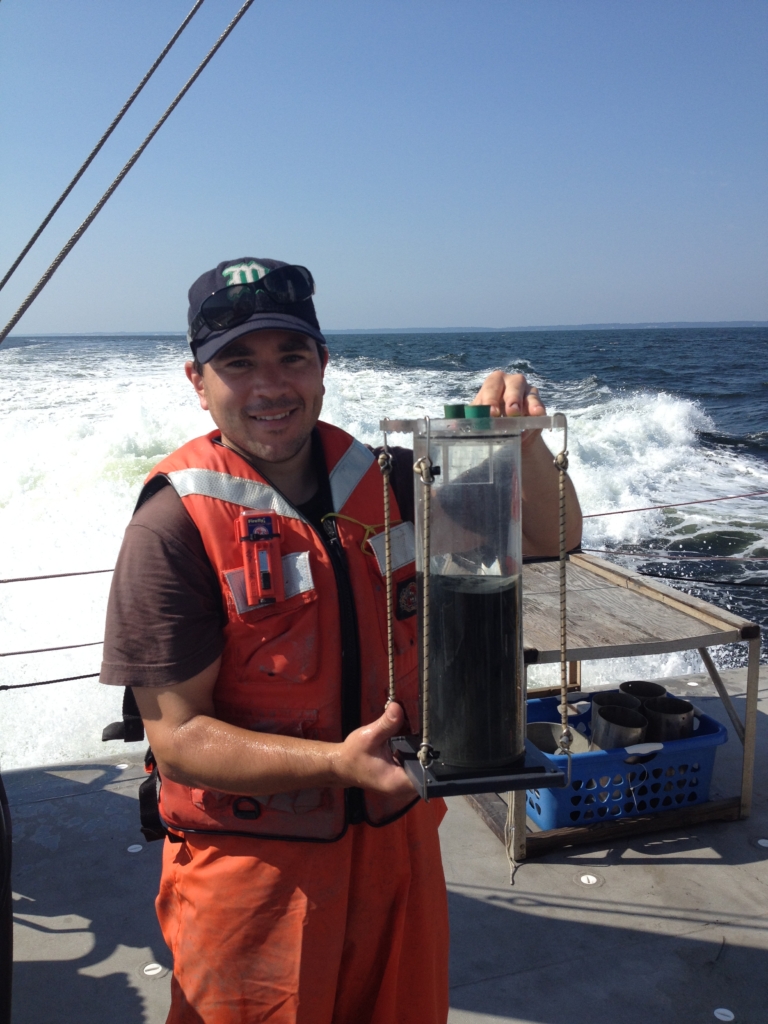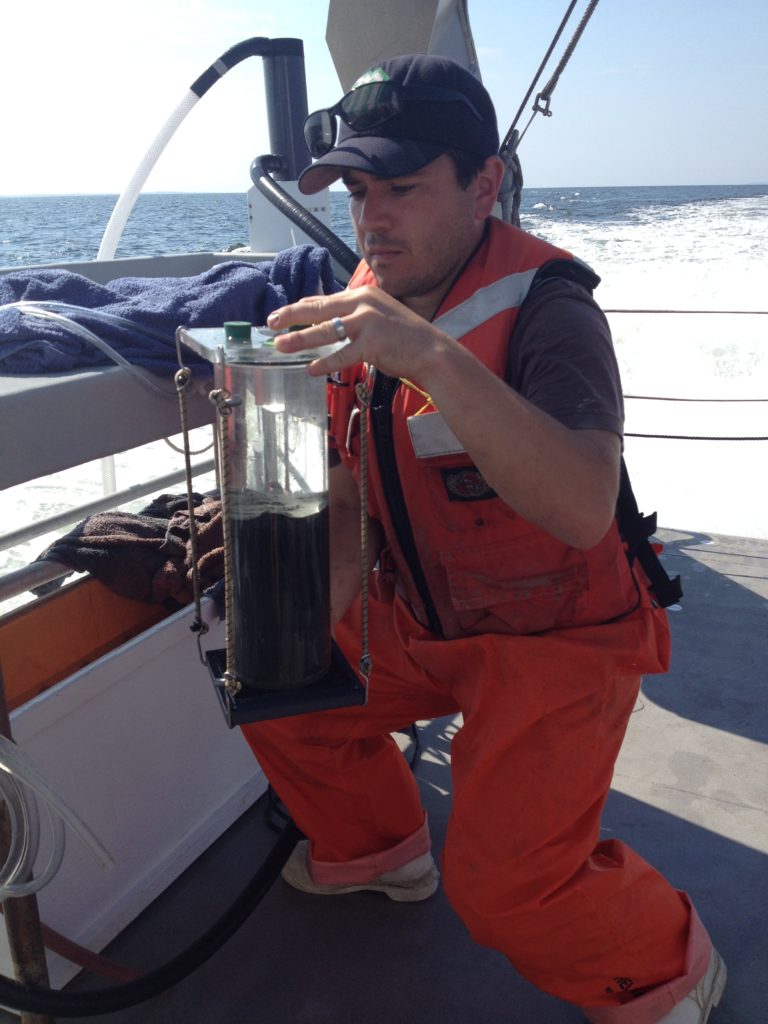Understanding the Dynamics of the Chesapeake Bay’s Dead Zone
It seems like everyone this year is talking about the record rainfall and enormous dead zone predicted in the Chesapeake Bay. The story has been all over the news (e.g., The Bay Journal, Baltimore Sun, and ScienceDaily, to name a few).

Jeremy Testa holding a sediment core from the anoxic mid-Bay region. The blackish-grey sediments, usually a brown-orange color at the surface, are depleted of oxygen.
Jeremy Testa, a professor at the University of Maryland Center for Environmental Science Chesapeake Biological Laboratory, is one of the researchers who predicts and measures the Bay’s dead zone every year.
The dead zone, or an area of low or no oxygen, develops yearly after springtime rains flush nutrients from the watershed into the main stem of the Bay, causing algae that thrive on those nutrients to bloom. The algae block sunlight, and when they die, they are decomposed by aerobic bacteria that remove oxygen from the water, causing areas of dangerously low oxygen in deep waters.
This year, the entire watershed experienced record rainfall, flushing in an extra 37.9 million pounds of nitrogen above average levels into the Bay.
Testa and his colleagues, Vyacheslav Lyubchich and Donald Scavia predicted that the hypoxic, or low-oxygen, area of the Bay would be 2.1 cubic miles, and that between 0.49 to 0.63 cubic miles would be anoxic, or have basically no oxygen.
Understanding the model
Testa’s team uses multiple models to predict and analyze the dead zone each year, including fine scale, three dimensional models. 3D models allow the team to couple the movement of water with biology and chemistry at the time scale of minutes and seconds so that they can tease out what is driving low oxygen in a way that can’t be done with measurements alone.
The team also uses simple statistical models that are driven by large-scale variables like Susquehanna and Potomac River nutrient loading so they can estimate the volumes of anoxic and hypoxic waters that are likely to take place in the Bay each summer. They release a report of their expectations in the late spring.
Generally, the hypoxia model has been accurate. Years with strong summer wind events can negatively affect the predictions for the mid-summer, but overall, it’s a strong model. The anoxia forecast model has also performed well, but has been over-predicting in the last 5-10 years and the team is working to recalibrate that model for a potentially positive change in the Chesapeake.
The Maryland Department of Natural Resources takes bi-weekly samples from the Bay throughout the summer to measure the dead zone. So far, the results have been mixed: in early June, they found an above-average dead zone consistent with the forecast report, but in late June they found that low-oxygen waters were lower than usual. It’s too early to say how big the dead zone could be throughout the rest of the summer months.
Is the dead zone a good indicator of Bay health?
While low-oxygen areas in the Bay are an obvious indicator of Bay health, it’s difficult to use dead zone size to influence management decisions. “One of the limitations of seasonal forecasting is that it only incorporates nutrient loading from major tributaries: the Susquehanna and the Potomac. It’s just a bulk estimate of loading,” explained Testa. “It’s less informative to overall management because it doesn’t give a clear picture of exactly where nutrients are coming from on land.”
Despite this downside, the forecast is essential to keeping an eye on the effects of variations in climate and changing nutrient loads on the Bay. The dead zone forecast also puts water quality back into the public eye.
“Long term movement towards better stormwater practices will make the water quality response to storms much better,” added Testa. “For example, putting a bunch of fertilizer on the ground before a storm is not a good idea. Individuals can learn more and pay attention to the weather, and those behavior changes should add up.”
Effects of the dead zone
 While fish and crabs can simply swim away from areas of low oxygen, immobile species like some invertebrates are left vulnerable. A regularly recurring dead zone can kill off benthic invertebrates or negatively impact their reproduction.
While fish and crabs can simply swim away from areas of low oxygen, immobile species like some invertebrates are left vulnerable. A regularly recurring dead zone can kill off benthic invertebrates or negatively impact their reproduction.
The dead zone can also cause a positive feedback loop that leads to more hypoxic conditions. If nutrients that readily accumulate in low oxygen areas aren’t flushed out, they can fuel additional algal growth. “Dead zones potentially increase the capacity to retain nutrients in the water,” explained Testa, instead of the nutrients being released as gases into the atmosphere or trapped in sediments.
Scientists are also looking into how sea grasses can affect and are affected by low oxygen water. In general, it’s difficult to link sea grass recovery and dead zone forecasts because they happen in different areas of the Bay. Sea grasses tend to live in shallow water, whereas the dead zone typically takes place in areas greater than 20-30 feet deep.
However, scientists are interested in how grasses could be used to decrease the dead zone, particularly in the Susquehanna flats. Here, freshwater plants could act as a filter between water coming from the river before it enters the Bay. The grasses here might be slowing down the water to trap sediments and particulate nutrients, or also could be allowing denitrification to occur in the oxygen-rich environments around their root systems.
Dead zone management and looking forward
Testa, CRC Director Bill Ball, and many other researchers were recently asked about their opinion on using aeration in the deep waters of the Bay as a way to potentially reduce the dead zone in a Bay Journal article. The article follows some recent studies done by the Chesapeake Bay Program testing aeration at a very small scale.
Lora Harris of UMCES has been studying aerators in Rock Creek that have been there since the 1980’s, and they’ve seen a positive response in water quality there.
Despite these positive findings, scientists are skeptical of how to scale up this solution into the deepest parts of the Bay. “Compelling simulations and studies have been done, but we need fundamental observations to try to get a clearer picture of how this would work,” said Testa. Others have called for a larger pilot study to figure out how aeration would work in a large body with tides and other compounding factors.
While aeration could help decrease the volume of low-oxygen water, there are other problems with nutrient pollution that can’t be fixed with aeration. “Aeration is an engineering solution to just one consequence of the problem. It won’t necessarily do anything to help with the other positive gains from reducing nutrients,” said Testa. “Local effects of water quality might not be helped by aerating the main stem, and we could lose momentum on Bay-wide goals by putting a bandaid on this one issue.”
